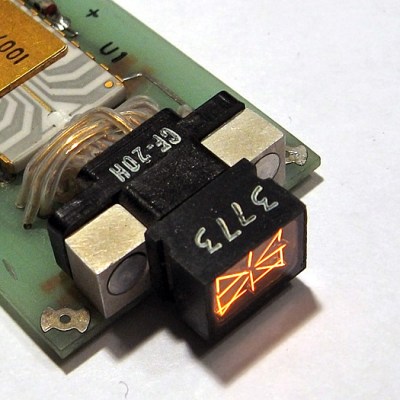It’s easy to take display technology for granted nowadays, but the ability to display data in a human-readable way was not always easy. This is demonstrated well by the Pinlite 30003 Alphanumeric Display Module, a four-character display that was pure luxury for its time.

Not only were the 17 segments that make up each display capable of showing any letter or number, but they were even daylight-readable! Each of those 17 segments is an incandescent lamp filament, which is how the required brightness was achieved. The sturdy module shown here holds four such displays, each of which is on its own pluggable board with a dedicated character decoder chip directly behind it.
As [AnubisTTL] points out, the resulting unit is bulky, has terrible character spacing, and was no doubt very costly. By today’s standards, it is almost unimaginably heavy, hot, and impractical. But before high-brightness LEDs were a thing, a daylight-readable alphanumeric character display was really something special. It would absolutely have been worth the money and effort to the right people.
Before small and efficient displays were commonplace, the solution to the problem of how to display data efficiently and in an easy-to-read format took a lot of really unusual (and clever) turns as engineers worked around the limitations of the time. This resulted in oddities like the SD-11 Sphericular Display, which is mostly empty space on the inside. Another great example is the Eidophor, a projector from before projectors were even a thing.
















A Numitron by any other name…
The aviation industry refers to them as Wamco Displays.
@Wolf said: “The aviation industry refers to them as Wamco Displays.”
Wamco started in 1968 and is still in business today.[1] But it seems Wamco no longer makes the incandescent minitron displays. The small 17-segment display is Wamco model KW205-AL and if you can find one, they’re usually quite pricey. This single KW205-AL [2] costs $130.00. This one [3] is a whopping $700.00! And remember that’s just the display itself, no attached electronics.
1. Wamco Inc.
https://www.wamcoinc.com/
2. Wamco KW205-AL $130.00
https://www.ebay.com/itm/Wamco-KW205-AL-Lamp-Incandescent-/233711675339
3. Wamco KW205-AL $700.00
https://skygeek.com/wamco-kw205al-numeric-readout.html
These are Minitrons. Same operating principle as Numitrons, but different packaging.
What was the primary application for these? Elevator displays?
Well, Burroughs made computers.
Generally, expensive = military. Maybe NASA.
Elevators at that time would probably mostly have been using indicators that had a single light bulb for each floor and a metal plate with the letters and numbers cut into it.
Is it just me, or do these classic displays look more “real” than what we’ve got now?
OLED and modern 7 segment displays look flat, like painted objects, while these here look lively, physical real and actually “working”.
I would say so. I have way too much test gear- multimeters, scopes, counters, signal gens, wave gens, and so on, and the ones I most use are not the latest with 16M color and so on, but the VFD and LED classics (Agilent 34401A, E3634A, 33120A AWG, Fluke 45 and 8840A, Fluke 8000A even), as the specs are just as good as the current units and there is less– crap. I can look at the display and not need to try to figure it out. Not to say the more modern units have no place in my life (real time graphs without needing the computer interface software, for example, or ranges outside the capability of older gear), but they are not the first choice, for me, for most day-to-day test and measurement.
I will admit, though, that my favourite displays are not on the most capable gear. I love the 4X7 dot displays HP used in the 1970’s, like on the 5300A and the 4369A. Readable like crazy, and elegant.
I like this one, with Saturn planet inside, but outside my price range:
https://www.ebay.com/itm/154589845669
I remember having a calculator back in the day with that style display.
I still have a Kenwood TS-450S/AT with a VFD. I think that VFD’s are just
beautiful!! Sharp, clear and bright.
I have the same radio. Works perfectly except for the VFD!
Hey, those are the missile silo launch control displays from wargames :)
Military and space applications?
A bunch of red hot wires around fuel and ammo doesn’t sound ideal.
You may have forgotten the *in a vacuum sealed glass envelope* bit. These are basically just incandescent bulbs with flat tubes and multiple filaments arranged into an alphanumeric display format.
I’ve got two of these 16 segment minitrons but with a larger package kicking around somewhere in my parts drawer but sadly one has a few burned out segments. Wish I had at least four fully working ones to make a clock out of.
Thank you! I’ve just spent too many minutes looking for the 17th segment. I assumed it was a typo (repeated a half a dozen times).
I’ll use this post to confirm 16 segments and put my OCD to rest.